#New Soil
Explore tagged Tumblr posts
Text
Awen Ensemble - Dùthchas - pastoral jazz from Leeds, a 5-track coda to their April 2024 album Cadair Idris
Awen Ensemble are a Leeds based contemporary jazz collective. The 7 piece outfit take inspiration from modal tradition, spiritual jazz, and folk music from around the globe, creating compositions that are melodically focused and groove driven. Featuring a vibraphone, spoken word and a Celtic mystique, Awen Ensemble bring a unique offering to the jazz table.
3 notes
·
View notes
Text
The Legacy of Jackie McLean: A Jazz Pioneer
Introduction: Jackie McLean, born ninety-three years ago today on May 17, 1931, in New York City, was a seminal figure in the world of jazz. His innovative approach to the saxophone and his deep commitment to the art form left an indelible mark on jazz history. This article explores the life, music, and legacy of Jackie McLean. Early Life and Influences: Born into a musical family, Jackie…

View On WordPress
#Andy Kirk Jr.#Art Blakey and the Jazz Messengers#Bluesnik#Bud Powell#Charles Mingus#Charlie Parker#Destination... Out!#Dig#Gene Ammons#George Wallington#Jackie McLean#Jackie&039;s Bag#Jazz History#Jazz Saxophonists#Kenny Drew#Let Freedom Ring#Miles Davis#New Soil#One Step Beyond#Sonny Rollins#Thelonious Monk#Tiny Bradshaw
5 notes
·
View notes
Text
"Many people know about the Yellowstone wolf miracle. After wolves were reintroduced to the national park in the mid-1990s, streamside bushes that had been grazed to stubble by out-of-control elk populations started bouncing back. Streambank erosion decreased. Creatures such as songbirds that favor greenery along creeks returned. Nearby aspens flourished.
While there is debate about how much of this stemmed from the wolves shrinking the elk population and how much was a subtle shift in elk behavior, the overall change was dramatic. People were captivated by the idea that a single charismatic predator’s return could ripple through an entire ecosystem. The result was trumpeted in publications such as National Geographic.
But have you heard about the sea otters and the salt marshes? Probably not.
It turns out these sleek coastal mammals, hunted nearly to extinction for their plush pelts, can play a wolf-like role in rapidly disappearing salt marshes, according to new research. The findings highlight the transformative power of a top predator, and the potential ecosystem benefits from their return.
“It begs the question: In how many other ecosystems worldwide could the reintroduction of a former top predator yield similar benefits?” said Brian Silliman, a Duke University ecologist involved in the research.
The work focused on Elk Slough, a tidal estuary at the edge of California’s Monterey Bay. The salt marsh lining the slough’s banks has been shrinking for decades. Between 1956 and 2003, the area lost 50% of its salt marshes.
Such tidal marshes are critical to keeping shorelines from eroding into the sea, and they are in decline around the world. The damage is often blamed on a combination of human’s altering coastal water flows, rising seas and nutrient pollution that weakens the roots of marsh plants.
But in Elk Slough, a return of sea otters hinted that their earlier disappearance might have been a factor as well. As many as 300,000 sea otters once swam in the coastal waters of western North America, from Baja California north to the Aleutian Islands. But a fur trade begun by Europeans in the 1700s nearly wiped out the animals, reducing their numbers to just a few thousand by the early 1900s. Southern sea otters, which lived on the California coast, were thought to be extinct until a handful were found in the early 1900s.
In the late 1900s, conservation organizations and government agencies embarked on an effort to revive the southern sea otters, which remain protected under the Endangered Species Act. In Monterey Bay, the Monterey Bay Aquarium selected Elk Slough as a prime place to release orphaned young sea otters taken in by the aquarium.
As the otter numbers grew, the dynamics within the salt marsh changed. Between 2008 and 2018, erosion of tidal creeks in the estuary fell by around 70% as otter numbers recovered from just 11 animals to nearly 120 following a population crash tied to an intense El Niño climate cycle.
While suggestive, those results are hardly bulletproof evidence of a link between otters and erosion. Nor does it explain how that might work.
To get a more detailed picture, the researchers visited 5 small tidal creeks feeding into the main slough. At each one, they enclosed some of the marsh with fencing to keep out otters, while other spots were left open. Over three years, they monitored the diverging fates of the different patches.
The results showed that otter presence made a dramatic difference in the condition of the marsh. They also helped illuminate why this was happening. It comes down to the otters’ appetite for small burrowing crabs that live in the marsh.
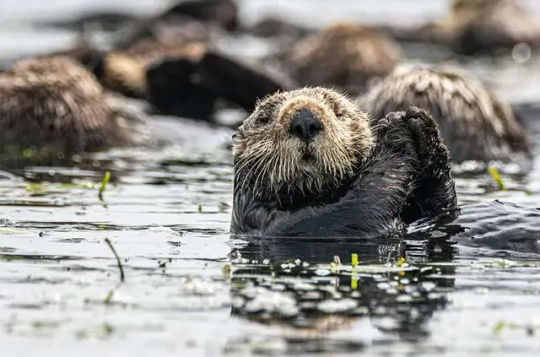
Adult otters need to eat around 25% of their body weight every day to endure the cold Pacific Ocean waters, the equivalent of 20 to 25 pounds. And crabs are one of their favorite meals. After three years, crab densities were 68% higher in fenced areas beyond the reach of otters. The number of crab burrows was also higher. At the same time, marsh grasses inside the fences fared worse, with 48% less mass of leaves and stems and 15% less root mass, a critical feature for capturing sediment that could otherwise wash away, the scientists reported in late January in Nature.
The results point to the crabs as a culprit in the decline of the marshes, as they excavate their holes and feed on the plant roots. It also shows the returning otters’ potential as a marsh savior, even in the face of rising sea levels and continued pollution. In tidal creeks with high numbers of otters, creek erosion was just 5 centimeters per year, 69% lower than in creeks with fewer otters and a far cry from earlier erosion of as much as 30 centimeters per year.
“The return of the sea otters didn’t reverse the losses, but it did slow them to a point that these systems could restabilize despite all the other pressures they are subject to,” said Brent Hughes, a biology professor at Sonoma State University and former postdoctoral researcher in Silliman’s Duke lab.
The findings raise the question of whether other coastal ecosystems might benefit from a return of top predators. The scientists note that a number of these places were once filled with such toothy creatures as bears, crocodiles, sharks, wolves, lions and dolphins. Sea otters are still largely absent along much of the West Coast.
As people wrestle to hold back the seas and revive their ailing coasts, a predator revival could offer relatively cheap and effective assistance. “It would cost millions of dollars for humans to rebuild these creek banks and restore these marshes,” Silliman said of Elk Slough. “The sea otters are stabilizing them for free in exchange for an all-you-can-eat crab feast.”"
-via Anthropocene Magazine, February 7, 2024
#otters#sea otters#conservation#erosion#coastal erosion#coastline#marshes#saltwater#marine science#marine biology#marine animals#sea creatures#ocean#sustainability#soil erosion#erosion control#crab#good news#hope
3K notes
·
View notes
Text
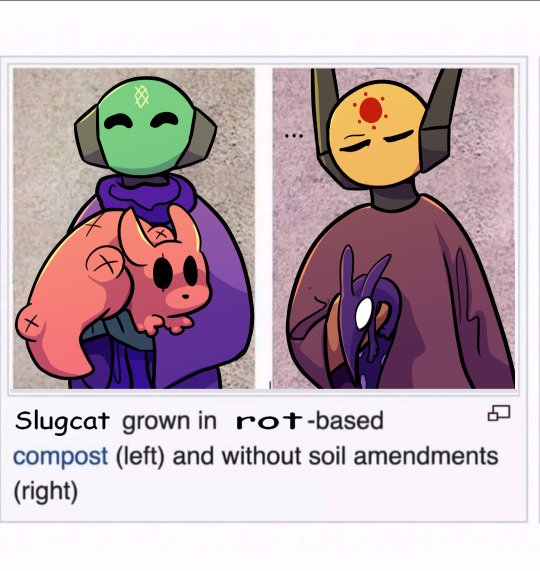
#hunter slugcat#spearmaster slugcat#no significant harassment#seven red suns#rain world downpour#new slugcat reproduction theory: grown in soil like a plant
1K notes
·
View notes
Text

I needed to do some proper art for Le Guin's The Left Hand of Darkness, which has shaken me so so deeply.
#corey art#the left hand of darkness#thinking about how the planet's name probably translates to Dark....#gethen is the world and getheny is one of the only literally translated words we get. it means new moon or lit. 'darkness'#i don't believe the dark in gethen means winter because they don't have axial tilt seasons - so no longer nights! i think it's a#soil/burial/birth metaphor. creation unfinished and all that yaknow
3K notes
·
View notes
Text


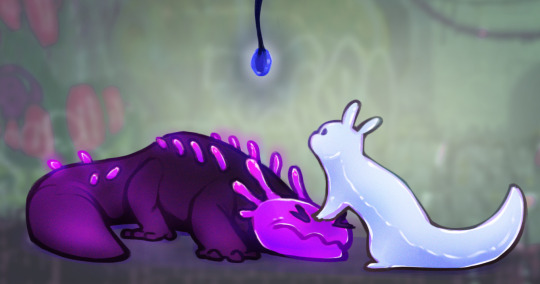

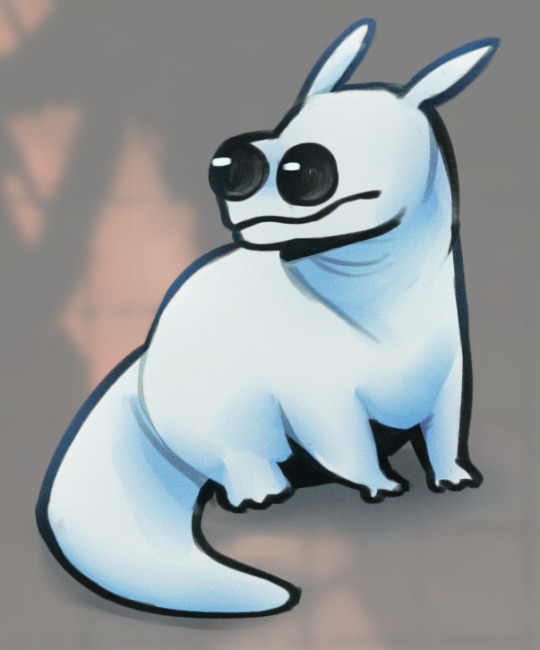
#my art#rain world#saint#gourmand#monk#survivor#posts more rain world art while you're not looking#points at slugs and lizards. weird ass cats i think#i started drawing tbh eyes as a joke. but guys i don't think it's a joke anymore#nips gets rounder every time i draw her#discovering fun new art techniques is easy. remembering to use them consistently however#posts completely unrelated art once a month like a farmer rotating her crops to keep the soil healthy#how in the world did i manage to stay focused on rainworld for like 6 months that one time#i want to play ace attorney so badly. but the brain worms#<- bg3 reference?
623 notes
·
View notes
Text
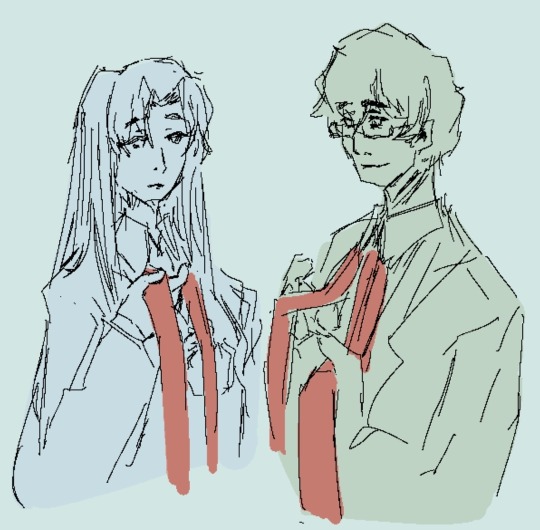

tie tying doodles w ramblings on it in tags
#lobotomy corporation#lobcorp#angela lobcorp#benjamin lobcorp#lobotomy corp spoilers#technically? never sure what and what not to tag#its cute.. the idea of benjamin showing her how to tie it. someone else probably dressed her in the first place before she woke up so she#likely didnt know how before. and you know ayin's ass isnt going to do that. besides the tie is reminiscent to benjamin as well#small doodle. wanted to do more i might depending on if i get motivated but her perception would allow her to process it and probably to it#first try. would there be pride? the pride she was able to pick up on such a thing quickly? a promise for later on down the line she would#be able to adapt? perhaps a hope? along with maybe a pride on angelas end for being able to do so. a small joy of able to do it first try.#even if her slower perception granted her a privilege humans didnt. it wasnt so sore of a thing at the moment. the wounds of time and pains#werent as of a all encompasing torrent as the hell she would he sprung into would be. the small joy or pride when she tied it later knowing#the reaction and knowing she got it first try. how capable she was. then for it to fade into monotony and a motion to do. a void of what#used to be there. no one to see and only to remember only to ever remember when she sees the tie that had been so strikingly like his#its like.. the feeling when you were so excited about something maybe you think of being a little silly later. but then it becomes so gutted#and devoid of what used to be there new memories maybe soiling the past experience. only to be left with what a void that you knew had been#filled with a positive light. its not there anymore. 'first try?' what a joke. were now on a try of countless repeats that have lost all#meaning and any ability to even ascribe meaning to.#anyways its only short doodles because im trying to find it in me to make a carmy angela piece and a yesod one rn. little scuffed but i#wanted to draw benj of men and angie#... at least i think she woke up clothed. no damn clue . would make most sense for her to be#it would be a little tortuous if she wasnt. either ayin doing it himself filled with rage and what was created with his own hands that#could never even begin to contain her warm but a mimicry and mockery done by his own two hands#then having to get close and even speak. or order or look at. but if it was in that situation benjamin wouldve done it actually with ayin#just staring through the glass not very respondent as benjamin has to help her into something or tell her what to do. having the man he#followed and was faithful to just... standing there and silent as he tries to help someone confused and only just beginning to become#concious open their eyes for the first time. all in all she was likely clothed before hand. still a bit disconcerting. not even awake or#begining to think at that point all but a body but not even one of flesh but one mechanical and man made - a Doll. given aspects and clothes#benjamin likely gave her a tie at that moment there if she were to be clothed. maybe a small marking of work or pass down?
47 notes
·
View notes
Text
Getting emotional about the salmon run again…
#solarpunk#no but seriously the way the indigenous people light fires to welcome the salmon home#and then wait to harvest them till enough have passed by#and the bears eat the salmon and their bodies rot to feed the soil#and that grows new trees that nourish the indigenous people and transpire rain#that keeps the water cycle in motion and feeds the sea#like nooooo I can’t my heart#hopepunk#environmentalism#social justice#cottagepunk#community#optimism#bright future#climate justice#tidalpunk#ecosystem#salmon#bears#forests
177 notes
·
View notes
Text
we both know what happened to you, why you’re out on your own
#[touching the soil of dan and harry’s relationship from 1992-2023 in my own personal headcanons] something terrible happened here#the loneliness at his core. gd#dan fielding#night court#new night court#*#dh#harry stone
54 notes
·
View notes
Text
Like I told @buckets-and-trees , a mob boss is always a most sinful temptation, but a man with a garden, vegetable beds and a greenhouse would have me give in even faster.
#I'm so ready to plant new seeds and dig in soil#i need a farmer or a gardener#or just a plant enthusiast to get dirty in the soil with 😏
35 notes
·
View notes
Text
Speaking of UK jazz, the new Ill Considered album Precipice is out today as well, from New Soil
Ill considered are a band comprising of musicians interacting with each other to create freely improvised music, based loosely around simple pre-written themes or composed on the spot. Deep grooves and plaintive melodies ranging from whispered chants to monstrous climaxes, the group react to the mood of the audience and the sonics of the room to create music that is unique to the moment.
youtube
Ahead of its release check out an extended, improvised session featuring Ill Considered and a group of special guests recorded down at Total Refreshment Centre to kick off a new chapter their new musical journey. Precipice (Live) features improvisations from: Idris Rahman, Pete Wareham, Buster Woodruff-Bryant, Art Themen, James Mollison, Nathaniel Cross, Theon Cross, James Yglesias
8 notes
·
View notes
Text
I've gotten into plantkeeping and I think the newest plant I own really cracks me up. I got this lavender plant and for the past few days, I would feel the soil to see if it needs watering (outside of watering cycles) and this lavender plant soil felt damp so I would skip watering. Eventually he got to this state:

I looked up solutions which plainly stated more water. I drowned his ass and this is him 2 hours later:

What a drama queen.
#lavender needs to stay in moist drained soil#gotcha#fanblog#plantblr#im a new keeper so go easy on me
107 notes
·
View notes
Text
"An environmental toxicologist in California is cleaning up areas contaminated with heavy metals or other pollutants using fungi and native plants in a win-win for nature.
Where once toxic soils in industrial lots sat bare or weed-ridden, there are now flowering meadows of plants and mushrooms, frequented by birds and pollinators: and it’s thanks to Danielle Stevenson.
Founder of DIY Fungi, the 37-year-old ecologist from UC Riverside recently spoke with Yale Press about her ongoing work restoring ‘brownfields,’ a term that describes a contaminated environment, abandoned by industrial, extraction, or transportation operations.
A brownfield could be an old railway yard or the grounds of an abandoned oil refinery, but the uniting factor is the presence of a toxic containment, whether that’s a petrochemical, heavy metal, or something else.
Noting that she had read studies about mushrooms growing around the Chernobyl nuclear plant, she came to understand further, through her work, that fungi are an extraordinarily resilient species of life that consume carbon, and even though petroleum products are toxic to plants, to mushrooms they are essentially a kind of carbon.
In fact, mushrooms break down several categories of toxic waste with the same enzymes they use to consume a dead tree. They can also eat plastic and other things made out of oil, like agrochemicals.
At the Los Angeles railyard, as part of a pilot project, Stevenson and colleagues planted a variety of native grass and flower species alongside dead wood that would incubate specific fungi species called arbuscular mycorrhizal fungi, which assists plants in extracting heavy metals like lead and arsenic from the soil.
Alongside traditional decomposer fungi, the mixture of life forms demonstrated tremendous results in this brownfield.
“In three months we saw a more than 50 percent reduction in all pollutants. By 12 months, they were pretty much not detectable,” Stevenson told Yale 360.
Decontaminating soil like this typically involves bringing in a bulldozer and digging it all up for transportation to a landfill. This method is not only hugely expensive, but also dangerous, as contaminated material can scatter on the winds and fall out of the backs of trucks carting it away.
By contrast, the plants that draw out the toxic metals can be harvested and incinerated down to a small pile of ash before cheap transportation to a hazardous waste facility.
The technique, which Stevenson says has some scaling issues and issues with approval from regulators, is known officially as bioremediation, and she’s even used it to safely break down bags of lubricant-soaked rags from bicycle repair shops.
“People who live in a place impacted by pollution need to have a say in how their neighborhood is being cleaned up. We need to empower them with the tools to do this,” she said."
-via Good News Network, July 16, 2024
#mushrooms#fungi#mycology#mushroom#contamination#bioremediation#hazardous waste#hazardous materials#soil#mining#heavy metals#good news#hope#ecopunk#solarpunk
1K notes
·
View notes
Text




tagged by @lilywatt, @inafieldofdaisies, @deputy-morgan-malone, and @josephslittledeputy to make my fics (/original ideas) into a penguin classic using these templates! tysm this was so much fun <3 <3 <3
presenting 4 jakesyb fics ("canon", werewolf au, viking au, slasher au) and 2 original work concepts under the cut:


taglist (opt in/out):
@la-grosse-patate, @g0dspeeed, @omen-speaker, @confidentandgood, @tommyarashikage,
@cassietrn, @trench-rot, @harmonyowl, @fourlittleseedlings, @carlosoliveiraa,
@aceghosts, @adelaidedrubman, @finding-comfort-in-rain, @socially-awkward-skeleton, @testyfestyenthusiast, @strangefable,
@alexxmason, and @deputyash
#wip: kneeling at the crossroads#wip: the horror and the wild#wip: valhalla rising#wip: the damaged#wip: the new apostles#wip: fingers in the father's soil#happy birthday 'the damaged' who was born literally a few hours ago#my edits
39 notes
·
View notes
Text
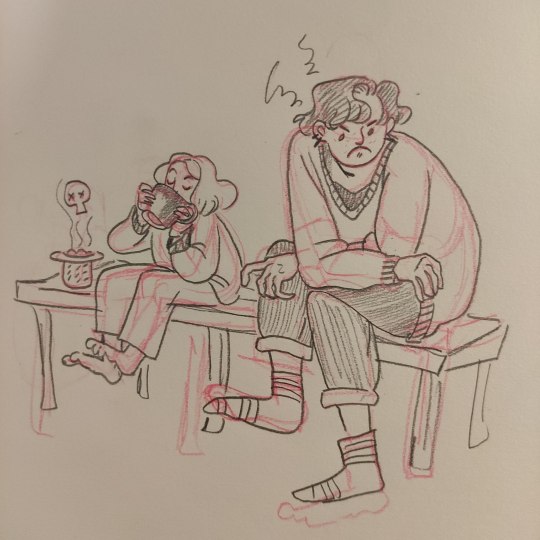
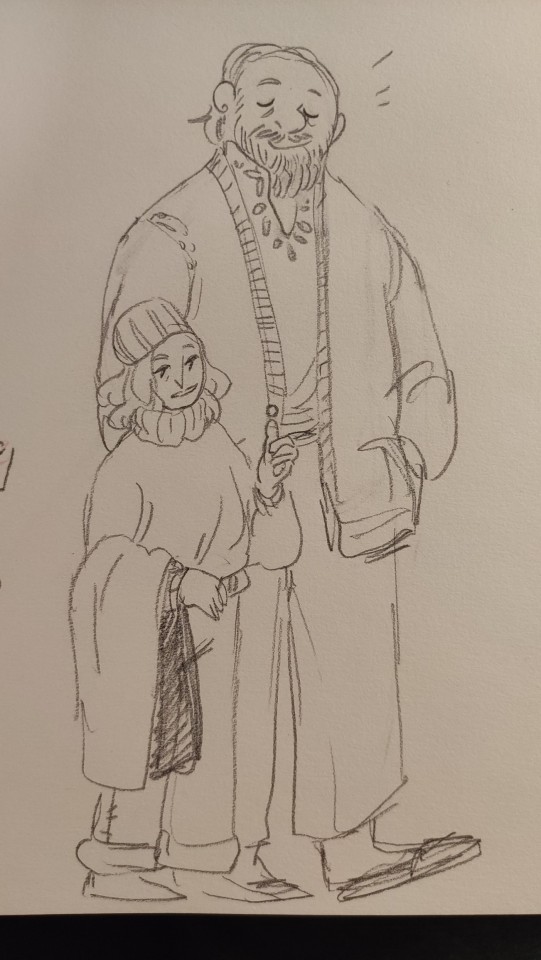

ouuhhh fae village years how i crave to draw them.... i need them to be middle-aged and little silly about it
#plant#varpu is in the town council against their will becauseby fae rules they are the emuu of florals#hates every second if it but also no one can get it done like him. there's a vision.#and they don't trust woodland fae to do contracts with humans without sidelining waterfront and florals again so FINE. He'll be there#Tauno does various old man activites such as observing construction and planting potatoes.#Has a weird little crafting circle where they mostly talk shit. Goes to expeditions to check on magic levels and different veil formations#good enrichment to him. also someone gotta do it and fae cannot properly observe the effects the landscape has on humans#sometimes their little group finds new young fae societies also. those pop out more often now that soil is more drenched with magic#varpu wants to join but sometimes he's too busy and it's a bummer :/ another time...#Also the kid in the first pic is Aino#tbh i havent finalized her personality yet. Teenager. What else can you say.
21 notes
·
View notes
Text
Lumon seriously took the guy who has suffered more than Jesus to woe's hollow and then did not expect him to upscale that place immediately lol
#Irving really went to woe's hollow and invented a new kind of pain and torment for everyone involved. dare I say KING#Milchick 'it'll be like you never existed' no man he's in the earth he's in the soil he's in the fire that will burn the company down#Severance#severance spoilers#Rewatching this episode and unlocking new emotions
15 notes
·
View notes